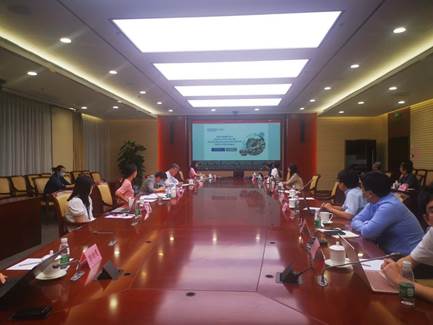On September 8, the third session of the second Advisory Committee Conference of the UNESCO International Engineering Technology Knowledge Center (IKCEST) was held in Beijing. As the main operators of the IKCEST Silk Road sub-center, the Network Information Center and the School of Continuing Education of Xi'an Jiaotong University (XJTU) were invited to attend the meeting. Chaired by academician Pan Yunhe, the meeting also had former Executive Vice-President of the Chinese Academy of Engineering, Professor Raj Reddy, member of the Advisory Committee for IKCEST, Academician Chen Zuoning, Vice President of the Chinese Academy of Engineering, Academician Li Guojie, Academician Wu Cheng, Academician Li Bohu, members of the Advisory Committee and colleagues of the Secretariat of IKCEST.

During the meeting, the Secretariat of IKCEST firstly presented the IKCEST 2020 annual report, after which participants gave recognition for the outcomes achieved by the IKCEST in 2020 and put forward suggestions on improving targeted services for users and promoting publicity of the database. Later, each sub-center of the IKCEST presented its activities and progress.

At the meeting, members of the IKCEST Silk Road Sub-center reported their achievements in the first half of 2020, and technical experts demonstrated the highlights of the Silk Road science and technology knowledge service training and platform. In the first half of the year, the Silk Road Sub-center successfully completed five major tasks including system upgrades, knowledge base application development, resource management, training and exchanges, optimization and modification. At the same time, the Silk Road Sub-center supported the whole-part integration between the sub-center and the IKCEST in four aspects including the study on the “Belt and Road” technological innovation index and the building of general data resources. Particularly after the sudden outbreak of COVID-19, for the first time, the Silk Road Sub-Center has provided Evidence-based Medical Databases from the DynaMed which include summaries of COVID-19 clinical evidence and 3,000 research papers, and has developed 38 English science courses on the COVID-19 with more than two million visits shortly after the release. Such steps help to offer the most authoritative, comprehensive and valuable resources for epidemic prevention and control, which has been praised by the Advisory Committee many times.
After the report, participants commended achievements of the Silk Road Sub-center and looked forward to the future. The experts suggested placing importance on improving user experience, shifting focus from “construction” to “operation and maintenance” and exploring a "feasible, practical, and applicable" path. It was also advised to develop the "core products" of the Silk Road sub-center, innovate the way of information release and build a professional knowledge service platform which was a strong guarantee for the cultivation of the "Belt and Road" talents.
It is reported that XJTU has undertaken the task of building the Silk Road Sub-center of the IKCEST under the guidance of the Chinese Academy of Engineering since November 2015. The Network Information Center (NIC) of the XJTU, as the Silk Road Project Management Office, together with the School of Continuing Education, the university library and the Faculty of Telecommunications, has explored a development path for training “Belt and Road” talents and has undertaken tasks of platform development, talents training and data resource management. Up to now, 73 sessions of the "Training Program for Silk Road Engineering Science and Technology Development" have been successfully held, attracting a total of more than 7,884 engineering and scientific professionals from 115 countries worldwide. This special training project has provided a solid foundation for Belt and Road countries to nurture top professionals and technical experts who are China-friendly.